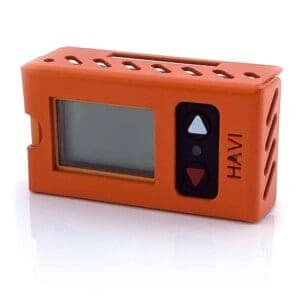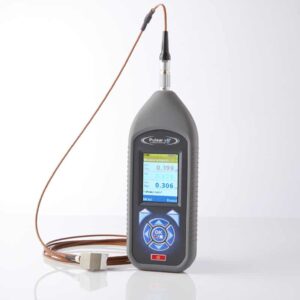Hand Arm Vibration at Work products from Pulsar Instruments™
-
 HAVi+ HAVS Trigger TimerFrom £75.00 (Ex. VAT/GST)
HAVi+ HAVS Trigger TimerFrom £75.00 (Ex. VAT/GST) -

7-year
Warranty
Pulsar vB² Human Vibration MeterFrom £3,164.00 (Ex. VAT/GST) -
 HAVi Watch – HAVS Monitor£253.00 (Ex. VAT/GST)
HAVi Watch – HAVS Monitor£253.00 (Ex. VAT/GST)
Overexposure to hand arm vibration at work (also known as occupational vibration) from power tools and vibrating machinery can impact the human body in several ways and cause permanent damage.
The UK Health and Safety Executive estimates there could be between 2 million people at risk of suffering from Hand Arm Vibration Syndrome (HAVS) in the UK alone.
A Hand-Arm Vibration meter like the Pulsar vB2 can be used to identify the vibration levels and risk from hand transmitted vibration from power tools and protect your employees.
How to recognise the symptoms
HAVS refers to a condition typically brought on in the workplace from vibration from the use of hand-held power tools and other powerful vibrating machinery. It is a painful, disabling, and irreversible condition affecting blood vessels, nerves and joints which over time can stop people from carrying out normal everyday tasks and cause disability, or in extreme cases the need for amputation. The condition can affect the body parts that make up your hand, wrist and arm and may develop slowly over time, becoming more severe the longer exposure occurs for.
Other related conditions caused by vibration and often covered generically under the HAVS term include Reynaud’s Syndrome and Vibration White Finger.
- Reynaud’s Phenomenon describes a condition that leads to the extremities of the fingers, toes and ears to become white. Reynaud’s Phenomenon can either be caused from unknown reasons (idiopathic reasons) this is referred to as Reynaud’s Disease, or it can be caused from the use of vibrating power tools, in this case, it is referred to as Reynaud’s Syndrome [1].
- Vibration White Finger Syndrome (also known as VWF or dead finger) finger refers to Reynaud’s Syndrome when it only affects the fingers and thumb of the hand.
- Bursitis is the inflammation and swelling of a bursa. A bursa is a fluid-filled sac that forms under the skin, usually over the joints, and acts as a cushion between the tendons and bones. The main symptoms of bursitis are pain, swelling and tenderness.
- Carpal Tunnel Syndrome (CTS) is a medical condition caused by compression of the median nerve as it travels through the wrist at the carpal tunnel. The main symptoms are pain, numbness, and tingling in the thumb, index finger, middle finger, and the thumb side of the ring fingers.
- Ulnar neuropathy is a disorder involving the ulnar nerve (between the wrist and elbow). It may be caused by entrapment of the ulnar nerve with resultant numbness and tingling.
What are the early symptoms?
- Tingling and numbness in the fingers, or not being able to feel things with your fingers. If you continue to use vibrating power tools then overtime the numbness in your hands could become permanent and you won’t be able to feel anything thing at all.
- Loss of strength in your hands, your grip may weaken and you may be less able to pick up or hold heavy objects. Over time this could get worse and make it difficult for you to pick up small objects such as screws or nails.
- In the cold and wet, the tips of your fingers go white then red and are painful on recovery (vibration white finger).
Fines and Compensation Claims for HAVS
If HAVS is caused in the workplace from continuous or excessive use of vibrating power tools it is a reportable industrial disease, and in many countries including the UK and European Union if workers can prove their employer has been negligent and their work has caused the condition (or industrial disease) they might be entitled to compensation. This compensation often depends on the extent of and how painful their HAVS condition is, their age, whether any permanent disability has been caused and whether they are able to carry on working.
The company will also more than likely be fined by the governing Health and Safety body in their country (e.g. the Health and Safety Executive (HSE) in the UK). These fines are often for very significant amounts of money.
We frequently report on the extent and value of HSE fines and claims in our Blog. Including most recently in our post HAVS Fines: Can you afford not to measure Hand Arm Vibration.
Tools that can cause hand-arm vibration syndrome include:
- concrete breakers, concrete pokers
- sanders
- disc cutters
- hammer drills and jackhammers
- chipping hammers, power hammers
- chainsaws
- brush cutters, hedge trimmers
- powered mowers
- scabblers or needle guns
- cut-off saws (for stone etc)
- impact wrenches
- Jigsaws
- needle scalers
- pedestal grinders
- polishers
- chisels
- powered lawn mowers
Which jobs and industries are most likely to involve hand-arm vibration?
Jobs requiring regular and frequent use of vibrating tools and equipment and handling of vibrating materials are found in a wide range of industries, for example:
- building and maintenance of roads and railways
- construction
- estate management (e.g. maintenance of grounds, parks, watercourses, road and rail side verges)
- forestry
- foundries
- heavy engineering
- manufacturing concrete products
- mines and quarries
- motor vehicle manufacture and repair
- public utilities (e.g. water, gas, electricity, telecommunications)
- shipbuilding and repair
Factors such as working in cold weather and an individual’s grip strength can affect the impact of vibration on a person.
Occupational health: controlling vibration at work
The Control of Vibration at Work Regulations 2005 requires employers to assess the risk of injury from vibratory tools in the workplace by completing a HAVS assessment. The two main elements you must monitor are vibration exposure level and vibration exposure time.
According to the HSE:
- Vibration Exposure Level is the vibration magnitude level emitted from the equipment your workers use and therefore is the level that your workers are exposed to.
- Exposure Time is the length of time that workers are being exposed to vibration.
Only when you are aware of the two elements above are you able to assess and control the level of vibration exposure to your workers. The vibration regulations implement Action and Limit Values for you to work to. These are:
- Exposure Action Value of 2.5 m/s2 A(8) at which employers should introduce measures in order to reduce exposure
- Exposure Limit Value of 5.0 m/s2 A(8) which should not be exceeded.
The HSE has also put together a crib sheet “8 Questions about vibration exposure monitoring” which many people will find useful.
Ready Reckoner
We’ve produced a Hand Arm Vibration ‘ready reckoner’ for calculating daily vibration exposures. All you need is the vibration magnitude (level) and exposure time provided by a vibration meter like the Pulsar vB.
What to do if you have a problem
If through your hand-arm vibration assessments you have identified that particular job roles are at risk of vibration then you are required to put in place actions to mitigate and reduce the impacts. Such actions could include labeling tools with maximum usage times, making sure that people do not exceed their daily exposure limit, and if they are at risk, then putting in place health surveillance of individuals at risk.

How Pulsar Instruments™ can help
Hand arm vibration syndrome a guide to controlling itThe Pulsar vB meter will help you assess the risks of exposure to vibration, and monitor and tackle these issues in the workplace by providing accurate and valuable data on your power tools.
You can also download our Free Guide:
5 Steps to controlling hand-arm vibration.
